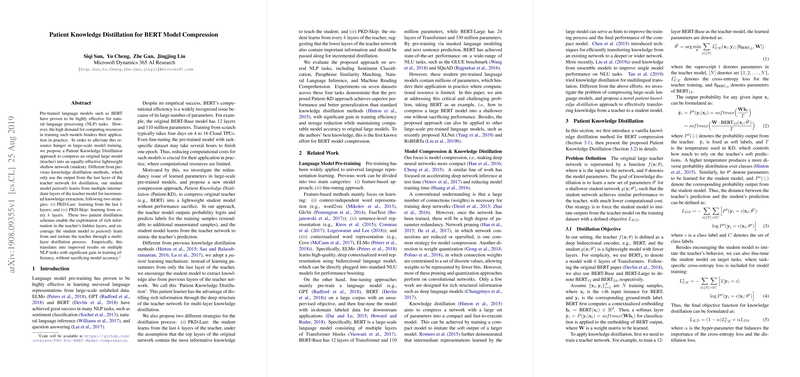Patient Knowledge Distillation for BERT Model Compression
The paper "Patient Knowledge Distillation for BERT Model Compression" presents a novel methodology for compressing large pre-trained LLMs, specifically BERT, while maintaining their performance on various NLP tasks. The technique proposed, termed "Patient Knowledge Distillation" (Patient-KD), utilizes multiple intermediate layers of the teacher model to guide the training of a more compact student model. This is in contrast to traditional knowledge distillation methods that primarily leverage the output from the last layer of the teacher model.
Key Contributions
- Patient Knowledge Distillation Approach:
The proposed Patient-KD method deviates from conventional knowledge distillation by facilitating the student model to learn from multiple layers of the teacher model. Two strategies are introduced: - PKD-Last: The student model learns from the last layers of the teacher model. - PKD-Skip: The student model learns from every layers of the teacher model.
- Model Compression: A successful demonstration of compressing BERT-Base (12 layers, 110M parameters) into 6-layer and 3-layer student models without significant loss of performance across various NLP benchmarks, achieving notable improvements in terms of model efficiency and inference speed.
- Comprehensive Evaluation: The paper evaluates the Patient-KD approach on multiple NLP tasks, including sentiment classification, paraphrase similarity matching, natural language inference, and machine reading comprehension, using datasets like SST-2, MRPC, QQP, MNLI, QNLI, RTE, and RACE.
Methodology
Distillation Objective:
The model compression process involves a distillation loss function combining the cross-entropy loss of the student's predictions with the ground truth and the KL-divergence between the student’s and teacher’s output distributions. The final objective includes an additional term for the Patient-KD loss, which measures the discrepancy between the normalized hidden states of the student and teacher models at selected intermediate layers.
Implementation Details:
Initial experiments involve directly fine-tuning 3-layer and 6-layer student models on specific tasks. Subsequently, vanilla knowledge distillation is applied, followed by Patient-KD, systematically comparing the performance improvements. Hyper-parameters such as temperature , balancing factor , and distillation coefficient are fine-tuned to optimize performance.
Experimental Results
Performance:
The results indicate that Patient-KD consistently outperforms the baseline and vanilla KD methods. Specifically, on the GLUE benchmark tasks, the 6-layer student model trained with Patient-KD achieves similar performance to the teacher model on tasks with substantial training data, like SST-2 and QQP, while reducing model size and inference time significantly.
Inference Efficiency:
Across various experiments, the compressed models achieve 1.64 to 2.4 times reduction in parameter size and 1.94 to 3.73 times improvement in inference speed compared to the original 12-layer BERT model.
Impact of Teacher Quality:
The paper also explores the effect of using larger teacher models such as BERT-Large (24 layers, 330M parameters) on student performance. Interestingly, results indicate that while a better teacher model (BERT-Large) generally provides more robust guidance, the most significant performance gains are realized when sufficient training data is available for the target tasks.
Implications and Future Work
Practical Implications:
The proposed Patient-KD approach offers a feasible solution for deploying BERT models in resource-constrained environments, balancing the trade-off between model accuracy and computational efficiency.
Theoretical Implications:
From a theoretical standpoint, this work underscores the value of leveraging rich internal layer representations in neural networks for effective model distillation, broadening the scope beyond the final layer’s logits typically used in traditional KD.
Future Developments:
Future research directions include pre-training BERT from scratch to address potential initialization mismatches, exploring sophisticated distance metrics for loss functions, and extending this approach to multi-task learning and meta learning frameworks.
In conclusion, Patient Knowledge Distillation for BERT Model Compression represents a significant advancement in model efficiency techniques, achieving competitive performance while substantially reducing computational demands. This work sets a precedent for future research in compressing and optimizing large pre-trained LLMs without compromising their intrinsic capabilities on diverse NLP tasks.
